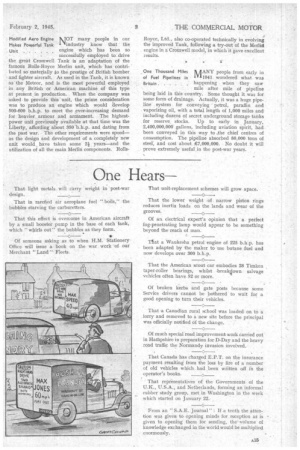Pass ing Comments
Page 16

Page 17

If you've noticed an error in this article please click here to report it so we can fix it.
Area .Restrictions A STRONG plea for priority rt for public-service passen Buses ger vehicles was made recently
Shoulti Not Apply to
in a letter to "The Times" from Sir Frederick Heaton, chairman and managing director of Thomas Tilling, Ltd., and chairman of a large number of other transport companies. It concerned town planning, and pointed out that although no general policy is proposed for regulating the operation of p.s. vehicles in and through the central zones of towns and cities, in certain urban areas it is intended to stop them on the periphery. This would mean that the individual car owner could proceed unchecked to his destination, whilst the lessfortunate person who has to travel by bus would be set down some considerable' distance away and be compelled to walk, whatever the weather of the urgency of the journey. Yet the car may be carrying only one person, whilst the bus may have GO. It can, .therefore, be appreciated how unfair this would be to users of the p.s. vehicle. Congestion may become such that some restrictions will prove essential, but regard should be had to the convenience of the'greatest number, and a bus, available for everybody, should be, not the first, but the last, type on which restrictions are imposed. COMMENT has arisen in
tired Become Transroad transport circles upon port Commissioners ? the fact that since the begin
ning of the war three appoint: ments as Regional Transport Commissioners have been conferred upon gentlemen who have already concluded what might be termed their primary careers, by retirement on pension after many years' service. Not with any personal feeling towards any individual, but purely as a matter of piinciple, the suggestion is made that the Ministry should, in future, adhere to a policy whereby such positions are filled by men who have not already devoted to some other work the major part of man's average span of life. Man-power demands during war-time might be cited in justification of appointing men who have retired, but, on the other hand, it can be argued that the importance of the task of the R.T.C., under emergency conditions, gives it a priority call on energy combined with capacity. In any event, our Military successes give hope of an early end of the war, in Europe at any rate, and with the peace will come transport problems of transition and post-war development which, it is stressed, will Place a heavy burden of responsibility upon transport commissioners. Modified Aero Engine Makes Powerful Tank
TatiOT many people in cur
'industry know that the engine which has been so successfully employed to drive Tank is an adaptation of the Merlin unit, which has contributed so materially to the prestige of British bomber and fighter aircraft. As used in the Tank, it is known as the Meteor, and is the raost powerful employed in any British or American machine of this type at preent in production. When the company was asked to provide this unit, the prime consideration was to produce an engine which would develop 500-600 b.h.p. to meet the ever-increasing demand for heavier, armour and armament. The highestpower unit previously available at that time was the Liberty, affording about 351) b.h.p. and dating from the past war. The other requirements were speed— as the design and development of a completely new unit would_ have taken some 2f years—and the utilization of all the main Merlin components. Rolls Unit the great Cromwell famous Rolls-Royce Royce, Ltd., also co-operated technically in evolving the improved Tank, following a try-out of the Merlid engine in a Cromwell model, in which it gave excellent results.
One Thousand Miles AfiANY people from early in of Fuel Pipelines in Iv11941 wondered what was
Britain happening when they saw mile after mile of pipeline being laid in this country. Some thought it was for some form of drainage. Actually, it was a huge pipeline system for conveying petrol, paraffin and vaporizing oil, with a total length of 1,000 miles and including dozens of secret underground storage tanks for reserve. stocks, Up to early in January, 2,400,000,000 gallons, including aviation spirit, had been conveyed in this way to ..the chief centres of consumption. The pipeline absorbed 80,000 tons of steel, and cost about £7,000,000. No doubt it will prove extremely useful in the post-war years.




















































